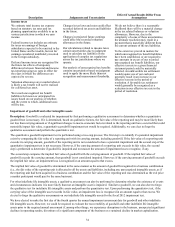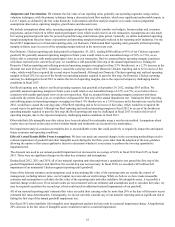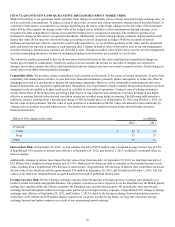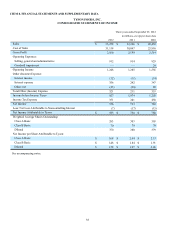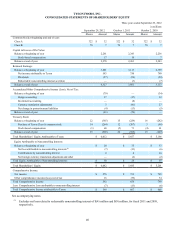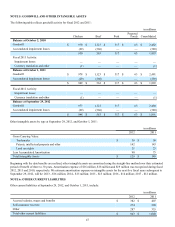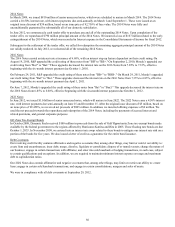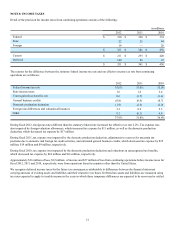Tyson Foods 2012 Annual Report Download - page 43
Download and view the complete annual report
Please find page 43 of the 2012 Tyson Foods annual report below. You can navigate through the pages in the report by either clicking on the pages listed below, or by using the keyword search tool below to find specific information within the annual report.43
Goodwill and Other Intangible Assets: Goodwill and indefinite life intangible assets are initially recorded at fair value and not
amortized, but are reviewed for impairment at least annually or more frequently if impairment indicators arise. Our goodwill is
allocated by reporting unit and is evaluated for impairment by first performing a qualitative assessment to determine whether a
quantitative goodwill test is necessary. If it is determined, based on qualitative factors, the fair value of the reporting unit may be more
likely than not less than carrying amount or if significant changes to macro-economic factors related to the reporting unit have
occurred that could materially impact fair value, a quantitative goodwill impairment test would be required. Additionally, we can elect
to forgo the qualitative assessment and perform the quantitative test.
The first step of the quantitative test is to identify if a potential impairment exists by comparing the fair value of a reporting unit with
its carrying amount, including goodwill. If the fair value of a reporting unit exceeds its carrying amount, goodwill of the reporting unit
is not considered to have a potential impairment and the second step of the quantitative impairment test is not necessary. However, if
the carrying amount of a reporting unit exceeds its fair value, the second step is performed to determine if goodwill is impaired and to
measure the amount of impairment loss to recognize, if any. The second step compares the implied fair value of goodwill with the
carrying amount of goodwill. If the implied fair value of goodwill exceeds the carrying amount, then goodwill is not considered
impaired. However, if the carrying amount of goodwill exceeds the implied fair value, an impairment loss is recognized in an amount
equal to that excess. The implied fair value of goodwill is determined in the same manner as the amount of goodwill recognized in a
business combination (i.e., the fair value of the reporting unit is allocated to all the assets and liabilities, including any unrecognized
intangible assets, as if the reporting unit had been acquired in a business combination and the fair value of the reporting unit was
determined as the exit price a market participant would pay for the same business). We have elected to make the first day of the fourth
quarter the annual impairment assessment date for goodwill and other indefinite life intangible assets.
We estimate the fair value of our reporting units using a discounted cash flow analysis, which uses significant unobservable inputs, or
Level 3 inputs, as defined by the fair value hierarchy. This analysis requires us to make various judgmental estimates and assumptions
about sales, operating margins, growth rates and discount factors and is believed to reflect market participant views which would exist
in an exit transaction. Generally, we utilize normalized operating margin assumptions based on future expectations and operating
margins historically realized in the reporting units' industries. For the fiscal 2012 impairment test of material reporting units requiring
a quantitative test, both our Domestic Chicken and Beef reporting units, which had goodwill at September 29, 2012, totaling $900
million and $563 million, respectively, utilized operating margins in future years in excess of the operating margins realized in the
most recent year. We assumed operating margins in future years generally would return to our normalized range, as we believe this is
consistent with market participant views in exit transactions. Some of the inherent estimates and assumptions used in determining fair
value of the reporting units are outside the control of management, including interest rates, cost of capital, tax rates and credit ratings.
While we believe we have made reasonable estimates and assumptions to calculate the fair value of the reporting units, it is possible a
material change could occur. If our actual results are not consistent with our estimates and assumptions used to calculate fair value, we
may be required to perform the second step of the quantitative test in future years, which could result in material impairments of our
goodwill.
During fiscal 2012, 2011 and 2010, all of our material reporting units that underwent the quantitative test passed the first step of the
goodwill impairment analysis and therefore, the second step was not necessary. In fiscal 2010, we recorded a $29 million full
impairment of an immaterial Chicken segment reporting unit's goodwill.
For our other indefinite life intangible assets, a qualitative assessment can also be performed to determine whether the existence of
events and circumstances indicates it is more likely than not an intangible asset is impaired. Similar to goodwill, we can also elect to
forgo the qualitative test for indefinite life intangible assets and perform the quantitative test. Upon performing the quantitative test, if
the carrying value of the intangible asset exceeds its fair value, an impairment loss is recognized in an amount equal to that excess.
The fair value of trademarks is determined using a royalty rate method based on expected revenues by trademark.
Investments: We have investments in joint ventures and other entities. We use the cost method of accounting when our voting
interests are less than 20 percent. We use the equity method of accounting when our voting interests are in excess of 20 percent and we
do not have a controlling interest or a variable interest in which we are the primary beneficiary. Investments in joint ventures and other
entities are reported in the Consolidated Balance Sheets in Other Assets.
We also have investments in marketable debt securities. We have determined all of our marketable debt securities are available-for-
sale investments. These investments are reported at fair value based on quoted market prices as of the balance sheet date, with
unrealized gains and losses, net of tax, recorded in other comprehensive income. The amortized cost of debt securities is adjusted for
amortization of premiums and accretion of discounts to maturity. Such amortization is recorded in interest income. The cost of
securities sold is based on the specific identification method. Realized gains and losses on the sale of debt securities and declines in
value judged to be other than temporary are recorded on a net basis in other income. Interest and dividends on securities classified as
available-for-sale are recorded in interest income.



